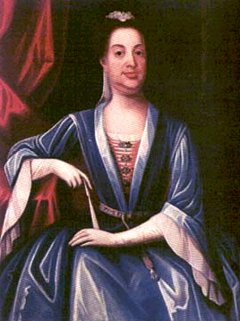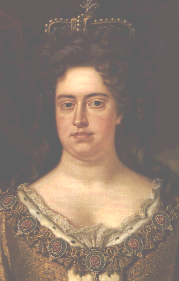Edward Hyde, Viscount Cornbury (1661-1723), could very well have been known as the pre-founder of King's College. He was an advocate for the placement of a college in New York City, but somehow his suggestions were overshadowed by Colonel Lewis Morris' statements on the matter, as Morris is more famously known as the college's pre-founder. Although documents lead to evidence of Cornbury's support of the college, his involvement with the college's founding has been clandestine because of his damaged reputation over the years.
Viscount Cornbury was the son of Henry Hyde, the second Earl of Clarendon. He came from a long line of reputable descendents including; his important father, a king as his uncle, a profitable marriage to Katherine, daughter of Lord O'Brien, and perhaps most beneficially, his cousin was Queen Anne. These connections provided him with a good education in Geneva and a seat in Parliament in 1685. His prospects sparkled, yet his reputation did not.
Cornbury was noted as being "a spendthrift, a grafter, a bigoted oppressor and a drunken vain fool." He encountered many problems while in England, including a scuffle with James II. As an Anglican, Hyde became one of the first army officers to desert James II, integrating himself with the victorious William and Mary. Many of his burdens were financial, and were eventually the reason he made his move to the American colonies. Because Cornbury often overindulged in his lavish tastes, he overspent a considerable amount of his income and found himself being pursued by numerous creditors. In an attempt to escape from his problems, Cornbury fled to the colonies with Queen Anne's blessing.
Immediately upon his arrival in New York in 1701, Anne appointed Cornbury as governor of New York. Only one year later, in 1702, the Queen added the title of governor of New Jersey to Cornbury's list of duties. The populace of both New York and New Jersey would learn that Cornbury was not a fit governor, as he was unruly and for the most part indifferent to the needs of the people.
When he first arrived in New Jersey in 1703 the colony was rife with factional and political tension. In what had earlier been a proprietorship of East and West Jersey, a group of political parties sought Hyde's favor as they fought with each other over such things as land, money, power and religion. Cornbury was indifferent to these issues, but he saw the possibility for personal gain, hence his poor reputation began.
Hyde gathered a group of politicians who shared his political sentiments, and they called themselves the "Cornbury Ring." Instead of simply allying himself with an existing faction, he created the Cornbury Ring. It engaged in such corrupt activities as grabbing land and looting public funds. Hyde and the Ring had an especially large grievance with the Quaker population, which dominated West Jersey politics. The Ring tried to disenfranchise the Quakers, attempting to seize control of the assembly. These unlawful tactics which Hyde resorted to were not successful, and the Cornbury Ring failed to control the assembly.
The Ring passed a number of bills that were designed to enhance Hyde's fortunes, both financially and politically. It pushed through a militia bill that included a fine on all those who refused to serve and allowed militia officers to levy taxes for the support of their forces. This severely hurt the Quakers, whose property was confiscated by the militia when they refused to pay. While this was a direct blow to the Quakers, the Cornbury Ring greatly benefited from the practice, gaining 1,000 pounds a year.
Looking at Viscount Cornbury's governorship in New York, it is apparent that he was equally as corrupt as he was in his New Jersey legislation. In New York, Hyde allied himself with the Anti-Leislerian party to secure gifts and a revenue. He twice dismissed uncooperative assemblies, who were largely uncooperative because of his impossible demands. And he even embezzled a large part of the money raised for the defense of the colony during Queen Anne's War.
An example of his unfair reign as governor of New York is when Hyde illegally seized a Presbyterian parsonage and a church in Jamaica, New York. He unjustly prosecuted the minister, Francis Makemie, for preaching without a license. This type of political tyranny, religious oppression, graft and theft were only the beginning of his soiled reputation.
Perhaps the most infamous characteristic of Edward Hyde is not his status as a corrupt politician, but rather that of a cross dresser. Numerous rumors have circulated that Viscount Cornbury liked to dress in women's clothes in order to have a likeness near to his cousin, Queen Anne. A painting hangs in the New York Historical Society whose description reads, "Viscount Cornbury, governor of New York and New Jersey (1702-1708)." The painting is a portrait of a man wearing a woman's clothes, and it was identified as being Cornbury in 1796, seventy-three years after his death. This painting is a piece of evidence that supports historians' uniform depiction of Hyde as a cross dresser.
There have been many stories told throughout history of his escapades as a transvestite. One was told by Horace Walpole in a conversation with his friend George James Williams. Walpole recounted,
"He was a clever man. His great insanity was dressing himself as a woman. Lord Orford [Walpole] says that when Governor in America he opened the Assembly dressed in that fashion. When some of those about him remonstrated, his reply was, 'You are very stupid not to see the propriety of it. In this place and particularly on this occasion I represent a woman (Queen Anne) and ought in all respects to represent her as faithfully as I can.'"
At this point in the conversation, Williams reacted, saying that his own father
"told him that he has done business with Cornbury in woman's clothes. He used to sit at the open window so dressed, to the great amusement of the neighbors. He employed always the most fashionable milliner, shoemaker, stay maker, etc. Mr. Williams has seen a picture of him at Sir Herbert Packington's in Worcestershire, in a gown, stays, tucker, long ruffles, cap, etc."
A letter was written in 1714 by the German diplomat Baron von Bothmer to Hanover relaying the rumor that when in the Indies Cornbury thought "it was necessary for him, in order to represent her Majesty, to dress himself as a woman."
This image was not one that the colony of either New York or New Jersey wanted to portray, and in 1707 an effort began to oust Hyde. The New Jersey assembly acted first, opening up an investigation of Hyde's conduct and drawing up a list of grievances. The assembly sent a copy of this list to the Board of Trade, asking the body to "relieve them from the oppressions they groan under by the arbitrary and illegal practices of his excellency."
New York followed suit in 1708, unanimously adopting resolutions condemning Cornbury's illegal activities in the colony. This double whammy perturbed Queen Anne, who dismissed Hyde of his duties in December of 1708, saying, "his near relation to [her] should not protect him in oppressing [her] subjects."
Upon his dismissal, Cornbury was arrested by the sheriff of New York for his debt. He stayed in a New York jail until the death of his father, when his inheritance enabled him to pay his debts and return to England. At the time of his death in 1723, Cornbury had become a symbol of despotism in America.
The immoral character of Viscount Cornbury, both in the public eye and within his personal life, has given him a disreputable name. If it had not been for this, he may have been known as the pre-founder of King's College. He is known more for his outrageous personality than for his political influence in the colonies. Many people who knew Cornbury shared Lewis Morris' assessment of him, which was as "a wretch who by the whole conduct of his life has evidenced he has no regard for honor or virtue." Bibliography
|  |
A resemblance? 
Lord Cornbury (courtesy of http://www.jersey-mall.com/pages/cornbury.htm) 
Queen Anne (courtesy of http://www.geocities.com/Athens/Troy/1355/)
|
 |
|
|
|